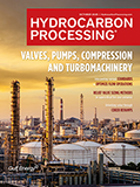Environment
Shell publishes reports on Sustainability, Climate & Energy Transition Lobbying and Payments to Governments
Shell plc has published its 2022 Sustainability Report, its 2022 Climate and Energy Transition Lobbying Report and its 2022 Payments to Governments Report.
Preem performs successful productions tests of Enviro’s recovered pyrolysis oil
Scandinavian Enviro Systems has been informed that the fuel company Preem has performed successful production tests of the recovered pyrolysis oil that Enviro recently supplied.
ADNOC to explore low carbon ammonia value chain in Germany’s North Rhine-Westphalia
ADNOC announced today that it will explore opportunities to support the climate-neutral transformation of industry through the creation of a low-carbon ammonia value chain with state government and industry representatives in Germany’s North Rhine-Westphalia.
Colombia's Ecopetrol must grow oil, gas output to fund transition
Colombia's Ecopetrol must focus on growing its oil and gas production to fund the transition towards renewables.
Chevron Lummus Global announces ISOFINISHING Award from BPCL
Chevron Lummus Global LLC announced that Bharat Petroleum Corp. Ltd. has selected its ISOFINISHING technology for a catalytic processing unit at the Mumbai Refinery in Mumbai, India.
German transport minister 'optimistic' EU e-fuels stand-off will be resolved
Germany's transport minister on Friday said he was optimistic a dispute between Berlin and Brussels over the future of combustion engine cars running on e-fuels was close to resolution, though some questions still needed clarifying.
Investors urge European chemical makers to take action on emissions
Investors managing more than $4 T in assets have told European chemical companies they must set out a path to move away from fossil fuels, saying that the sector's role in greenhouse gas emissions has been overlooked.
NOVA Chemicals sets bold ESG aspirations to lead the plastics circular economy
NOVA Chemicals Corporation announced sector-leading ESG ambitions to drive the circular economy for plastics, in line with its vision to become the leading sustainable polyethylene producer in North America.
Clean Planet Energy award Wood advanced plastic recycling projects across the US and UK
Wood, the global consulting and engineering company, has been awarded a contract for FEED and EPCm services by Clean Planet Energy.
Air Liquide paves the way for ammonia conversion into hydrogen with new cracking technology
Air Liquide announces the construction of an industrial scale ammonia (NH3) cracking pilot plant in the port of Antwerp, Belgium.

- INEOS to invest €250 MM in Lavera cracker modernization project in France 11/19
- BASF adds ISCC EU certification to certified biomass-balanced methanol portfolio 11/19
- Ducor Petrochemicals, Blue Circle Olefins partner to create a fully circular supply chain for polypropylene 11/18
- World's first: Air Liquide’s innovative technology converts ammonia into hydrogen at industrial scale 11/18
- Borouge to supply advanced polyolefin solutions for next-generation vehicles 11/18
- ASTM International signs MoU with Gulf Cooperation Council Laboratory Company for Technical Services (GCC Lab TSCo.) 11/18




